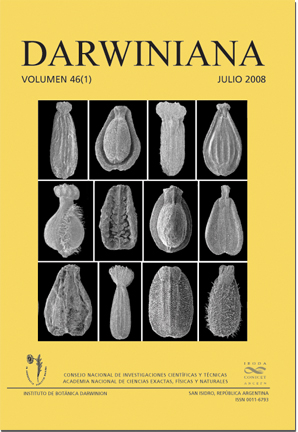Reproductive biology of Cologania broussonetii (Fabaceae, Faboideae)
DOI:
https://doi.org/10.14522/darwiniana.2014.461.82Keywords:
Argentina, Chaco Serrano, Cologania, Fabaceae, reproduction, self-compatibilityAbstract
The breeding system, fruit set, seed set, floral visitors and pollination of Cologania broussonetii were studied. Four pollination treatments were applied: autogamy, geitonogamy, xenogamy, and natural pollination (flowers exposed to pollinators). The frequency of visits was recorded, and pollen grains deposited per stigma on bagged (self pollen deposition) and exposed flowers were counted. The results indicate that this species is self-compatible and autogamus. A small number of low quality fruits and seeds (lowest mass and germination capability) were obtained by spontaneous self-pollination. When fruits obtained by natural pollination were analyzed, a specific pattern of seed formation was detected: ovules were successively fertilized from the apical to the basal portion of the ovary. However, no pattern was observed for seed abortion. The frequency of visits of possible pollinators (species of Bombus) was very low. The number of pollen grains per stigma was similar on bagged and exposed flowers. Nevertheless, the comparison of quantity and quality of fruits and seeds obtained by natural and autonomous self-pollination suggests that the visits of pollinators contribute to increase the quality of seeds (higher mass and germination capability).Downloads
Published
31-07-2008
How to Cite
Musicante, M. L., & Galetto, L. (2008). Reproductive biology of Cologania broussonetii (Fabaceae, Faboideae). Darwiniana, Nueva Serie, 46(1), 7–16. https://doi.org/10.14522/darwiniana.2014.461.82
Issue
Section
Reproductive Biology
License

Starting on 2012, Darwiniana Nueva Serie uses Licencia Creative Commons Atribución-NoComercial 2.5 Argentina .






